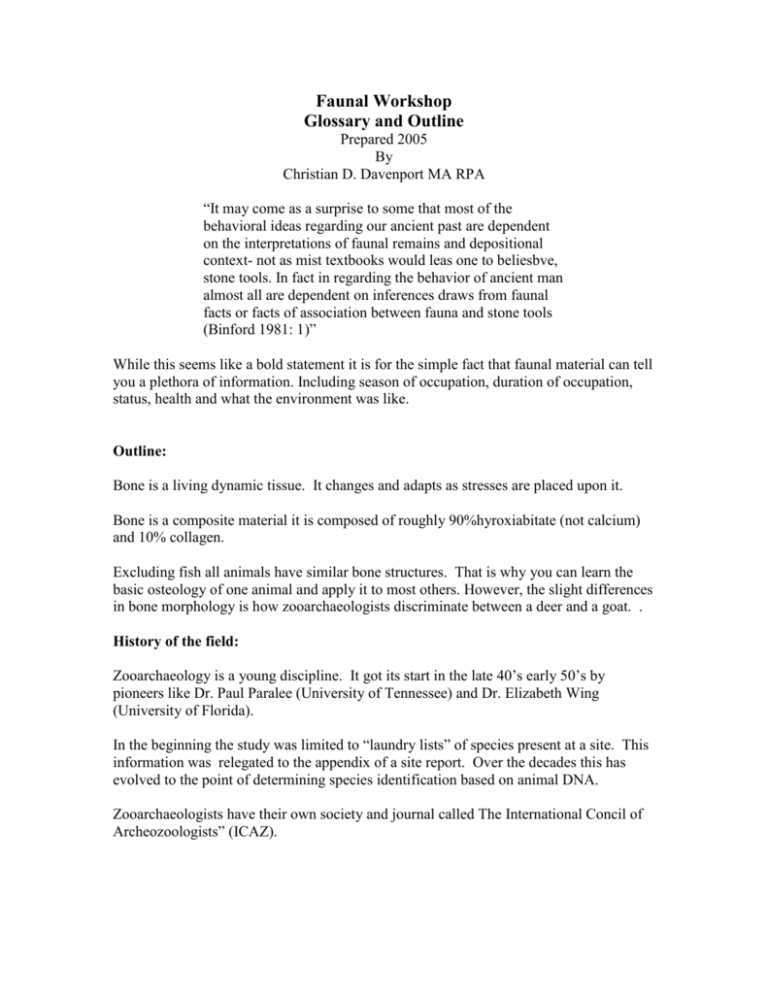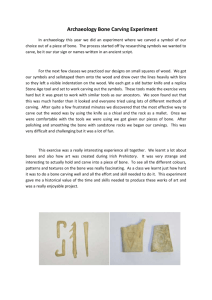link to this document in Word format.
advertisement

Faunal Workshop Glossary and Outline Prepared 2005 By Christian D. Davenport MA RPA “It may come as a surprise to some that most of the behavioral ideas regarding our ancient past are dependent on the interpretations of faunal remains and depositional context- not as mist textbooks would leas one to beliesbve, stone tools. In fact in regarding the behavior of ancient man almost all are dependent on inferences draws from faunal facts or facts of association between fauna and stone tools (Binford 1981: 1)” While this seems like a bold statement it is for the simple fact that faunal material can tell you a plethora of information. Including season of occupation, duration of occupation, status, health and what the environment was like. Outline: Bone is a living dynamic tissue. It changes and adapts as stresses are placed upon it. Bone is a composite material it is composed of roughly 90%hyroxiabitate (not calcium) and 10% collagen. Excluding fish all animals have similar bone structures. That is why you can learn the basic osteology of one animal and apply it to most others. However, the slight differences in bone morphology is how zooarchaeologists discriminate between a deer and a goat. . History of the field: Zooarchaeology is a young discipline. It got its start in the late 40’s early 50’s by pioneers like Dr. Paul Paralee (University of Tennessee) and Dr. Elizabeth Wing (University of Florida). In the beginning the study was limited to “laundry lists” of species present at a site. This information was relegated to the appendix of a site report. Over the decades this has evolved to the point of determining species identification based on animal DNA. Zooarchaeologists have their own society and journal called The International Concil of Archeozoologists” (ICAZ). How do you refer to animals and why do we use Latin words. So why do Zooarchaeologist’s use zoology’s taxonomic order and not common names to discuss an animal? The answer is best illustrated with another question. What is the difference between a polecat, and skunk or a cougar, puma and mountain lion? The answer, nothing, a polecat is a skunk and a cougar and puma are both the mountain lion. If you were only going to use common names than another zooarchaologist may not use the same terms. Taxonomic order is as follow for whitetail deer. Kingdom: Phylum: Class: Order: Family: Genus: Species: Common name Animal Cordata Mammal Artiodactyla Cervidae Odocoileous virginianus Deer Animal Cordata Mammal Artiodactyla Suidae Sus scrofa Pig Another rule to taxonomy is the first letter of the genus name is always capitalized and the species name is always lower case. Also on computers the both the genus and species are to be italicized or underlined for hand written documents. How do Zooarchaeologists infer so much information from animal bones? One question archaeologists who work on prehistoric sites want to know is when was a site was occupied. This is referred to as the season of occupation. To determine this an animal species must be present in a given location for only brief periods of time or have a condition that is seasonally sensitive. For example deer antlers. These structures grow, harden, are used and then fall off. Another question that is related to the one above is duration of occupation. How long were people at a given location. This is a tough question to answer because meat and thus animal bones only make up a small percentage of a diet. However, you can provide a rough estimate. Fore instance how many people can feed off one cow or deer? Status is an interesting question to address from faunal remains. The premise simplified is you are what you eat and what you eat has an intrinsic value. Fore instance in today’s society you are making a statement if you eat lobster and filet migon every night versus hot dogs and hamburgers. The same is true in the past. However, you have to make some assumptions or have historical documentation. For example few people today would considered jellied cow brains or feet a delicacy. However, in the Victorian period only the very wealthy could afford such treats (YUK!) What was the environmental like is another question zooarchaeologists are often asked to reconstruct. All animals have constraints of where they can live. These constraints are based on temperature, amount and type of water (salt vs. fresh), elevation, food and geographical location. Given that temperature is not constant the ecology of an area is constantly changing this has a direct impact on the animals that live in that area. If the environment changes a great deal the animals move, adapt or die. Micro mammals are some of the best indicators of the environment. Owls are great at depositing micro mammal remains. In the past it was thought you could date a site based on the type of cut marks that were present on a bone. To some extent this is still true we can examine a cut mark under a microscope and determine if a stone or metal tool made a mark. But this is not what site dates were based off of. It was thought if a bone was cut with a saw than it could not date to the 17th or early 18th centuries. However, we know now from work by David Landon in Colonial Boston that saws were used early on. Common Zooarchaeological idexes: Alometric studies: Estimating the amount an individual animal weighs based on osteological measurements and regression formulas. MAU: Minimum Animal Units. This was devised by Binford and counts sections of animals (how many legs). MNI: Minimum Number of Individuals. This is a measure of number of individual animals present at a site. There are statistical problems with this index so it is not used much anymore. Tends to give conservative estimates. MNE: Minimum Number of Elements: This counts the number skeletal elements present at a site. NISP: Number of Individual Specimens Present. This is account for the total possible number of animals present at a site. This tends to give exaggerated estimates. Glossary: Archeozoologist: A zoologist who studies animal remains from archaeological sites. “The European job description”. Synonymous with zooarchaolgoist. Common name: Everyday name of an animal Comparative collection: A collection of animals skeletons usually composed of road killed animals. Cut mark: Mark left on a bone from being butchered or eaten. Diaphsis: The shaft of a long bone. Diastoma: Space between the canine (eye tooth/fang and next tooth). Distal: Portion of a bone furthest from the head Medial: Located towards the midline of the body Micro mammal: Very small mammals (ex: mice, moles, voles and shrews) Lateral: Located away from the midline of the body Osteoblast: A specialized bone cell that creates new bone. Forming an osteon. Osteoclast: A specialized bone cell that destroys damaged bone. Osreocyte: An osteoblast that becomes encoplasolted/ “trapped” at within the newly formed bone forming an osteon. Osteon: A single bone cell. Proximal: Portion of the bone closest to the head. Schlep effect: How much of an animal returns to a site. (Example if you kill a bison and your base camp is 5 miles away. What parts of that animal are you going to bring back?) Subsistence: How an animal survives. For this field what animals were killed for food items. Taphonomy: Is the science of how objects move from the biosphere to the lithosphere. Zooarchaeologist: An archaeologist who studies of animal bones from archaeological sites. Synonymous with archaeozologists “The American job description”. Recommended Readings and References: Binford, Lewis 1981 Bones: Ancient Men and Modern Myths. Academic Press, Inc. New York Duncan, Gwyneth 1995 Nineteenth Century Subsistence Strategies at Harpers Ferry: A Synthesis of Faunal Analyses from Harpers Ferry National Historical Park. Journal of Middle Atlantic Archaeology. 11: 103-124. Gregory, William 1933 Fish Skulls: A Study of the Evolution of Natural Mechanisms. In: The American Philosophical Society Article II. Vol. 23. Gilbert, Miles 1993 Mammalian Osteology. Missouri Archaeology Society, Inc. Press. Gilbert, Miles, Larry Martin and Howard Savage 1996, Avian Osteology. Missouri Archaeology Society, Inc. Press. Kent, Bretton 1988 Making Dead Oysters Talk: Techniques for Analyzing Oysters from Archaeological Sites. Maryland Historical Trust Historic St. Mary’s City Jefferson Patterson Park and Museum. Landon, David 1996 Feeding Colonial Boston: A Zooarchaeological Study. Historical Archaeology: 30:1-153. Lyman, Lee 1994 Vertebrate Taphonomy. Cambridge University Press, London. Olsen, Stanley 1960 Post Cranial Skeletal Charaters of Bison and Bos. In: Papers of the Peabody Museum of Archaeology and Ethnology, Harvard University. Vol. 35(4). 1968 Fish, Amphibian and Reptile Remains from Archaeological Sites: Part 1 Southeastern and Southwestern United States appendix the Osteology of the Wild Turkey. In: Papers of the Peabody Museum of Archaeology and Ethnology. Vol. 56(2). 1996 Mammal Remains from Archaeological Sites: Part 1 Southeastern and Southwestern United States. In: Papers of the Peabody Museum of Archaeology and Ethnology. Vol. 56(1). Reitz, Elizabeth and Elizabeth Wing 1999 Zooarchaeology. Cambridge Manuals in Archaeology. Cambridge Press. London.







